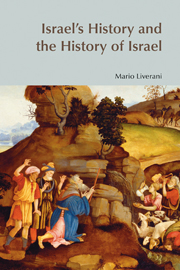Book contents
- Frontmatter
- Dedication
- Contents
- List of Tables and Illustrations
- Foreword
- Abbreviations
- IMPRINTING
- Part I A NORMAL HISTORY
- INTERMEZZO
- Part II AN INVENTED HISTORY
- Chapter 13 RETURNEES AND ‘REMAINEES’: THE INVENTION OF THE PATRIARCHS
- Chapter 14 RETURNEES AND ALIENS: THE INVENTION OF THE CONQUEST
- Chapter 15 A NATION WITHOUT A KING: THE INVENTION OF THE JUDGES
- Chapter 16 THE ROYAL OPTION: THE INVENTION OF THE UNITED MONARCHY
- Chapter 17 THE PRIESTLY OPTION: THE INVENTION OF THE SOLOMONIC TEMPLE
- Chapter 18 SELF-IDENTIFICATION: THE INVENTION OF THE LAW
- EPILOGUE
- Bibliography
- Index of References
- Index of Names of Persons and Deities
- Index of Placenames
Chapter 13 - RETURNEES AND ‘REMAINEES’: THE INVENTION OF THE PATRIARCHS
from Part II - AN INVENTED HISTORY
- Frontmatter
- Dedication
- Contents
- List of Tables and Illustrations
- Foreword
- Abbreviations
- IMPRINTING
- Part I A NORMAL HISTORY
- INTERMEZZO
- Part II AN INVENTED HISTORY
- Chapter 13 RETURNEES AND ‘REMAINEES’: THE INVENTION OF THE PATRIARCHS
- Chapter 14 RETURNEES AND ALIENS: THE INVENTION OF THE CONQUEST
- Chapter 15 A NATION WITHOUT A KING: THE INVENTION OF THE JUDGES
- Chapter 16 THE ROYAL OPTION: THE INVENTION OF THE UNITED MONARCHY
- Chapter 17 THE PRIESTLY OPTION: THE INVENTION OF THE SOLOMONIC TEMPLE
- Chapter 18 SELF-IDENTIFICATION: THE INVENTION OF THE LAW
- EPILOGUE
- Bibliography
- Index of References
- Index of Names of Persons and Deities
- Index of Placenames
Summary
The Fall of Babylon and the Edict of Cyrus
The exile (gôlāh), spent in a climate of resignation mixed with hope, did not last for ever. Jeremiah had at first exhorted the exiles to integrate themselves into the new milieu and start a new life with a positive attitude (see §11.2), dispensing with the vain hope that a more open attitude from the Babylonians (probably noted at the ascent of Awil-Marduk) could lead to the restitution of the temple furniture (Jer. 27.16–17). Finally he prophesied a period of 70 years (Jer. 25.11–12; 29.10), not for the duration of the exile, but for the Chaldean dynasty. He probably pronounced this prophecy when the imminent collapse of the Babylonian empire was universally expected: the 70 years fit rather neatly between 609, the Assyrian collapse, and 539, the conquest of Babylon by Cyrus.
The 70-year cycle of Yahweh's anger against his people is a motif already used to describe the anger of Marduk against his city of Babylon in the inscriptions of Esarhaddon (see the quotation in §7.6). It is the period of time needed to assure a full generational replacement of those responsible for the acts that caused the divine anger by their innocent offspring. According to Jeremiah (50–51), the fall of Babylon, seen as a kind of repetition of the fall of Nineveh and Assyria, will be caused – as usual – by barbaric hordes from the North (Jer. 50.41–43), at first (around 580–570) identified with the confederation of mountain tribes under the leadership of the Medes (Jer. 51.11, 27).
- Type
- Chapter
- Information
- Israel's History and the History of Israel , pp. 250 - 269Publisher: Acumen PublishingPrint publication year: 2005



